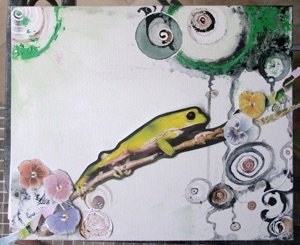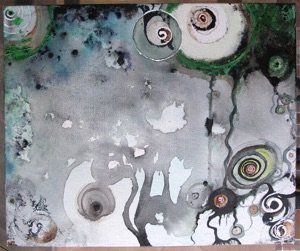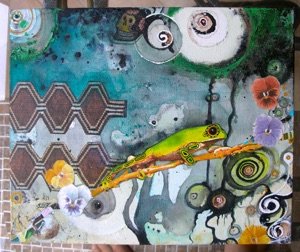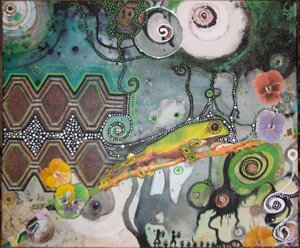
Mixed Media artwork - 'Cocoi Libre' by Jay Taylor
A defining characteristic of my artwork is that I paint entirely spontaneously. There's not a thought or a concept in my head - nor even an impetus beyond 'whatever's going on within me', and the creative urge itself - when I pick up a brush and pick out my paints.
'Cocoi Libre', my translation of Jason Weigner ’s photograph Bolivian Monkey Tree Frog, is one of my most popular artworks in terms of numbers of views and sales across the various platforms I exhibit on. It's also a personal favourite. As remarkable to me as the finished painting itself is the process by which it came to be, which is very different than anything else in my portfolio.
Part of the reason I'm sharing this piece on Steemit is as an example of pushing past one's usual boundaries, and leaping into uncharted territory. As any smart arse will tell you, this is an imperative endeavour to undertake from time to time as part of destroying the notion of oneself as a finite, predictable thing with parameters set in stone! ;o)
'Cocoi Libre' ('Free-living Frog', roughly) was created as part of a photographer/artist collaboration project on a website called redbubble.com. I'd entered a photograph of my own into the project to be translated by another artist into a painting. The organiser extracted a promise from me that I'd also choose a photo and translate it into a painting, and the rather reluctant journey into the jungle of 'having a remit' began...!
Choosing Jason's photograph was as much of a surprise to me as to anyone else - I usually shy away from figurative work, and there were several abstract photographs in the selection on offer which I could have picked instead. But when I saw The Frog, it was love at first sight. I asked Jason's permission to proceed, he gave me the go ahead, and... the panic set in!
WHY had I chosen a photograph which required figurative work? Well, for the love of Frog, of course! See Frog. Love Frog. Paint Frog....Meep!

After several days of wrestling with the foolhardiness of my choice, I decided to stop prevaricating and force myself to get on with it. I printed out copies of The Frog and stuck them on the wall, on my desk, in the bathroom... I started researching The Frog online. I asked Jason to tell me about The Frog, and Frog's neighbours, the Ayore people. I fell in love with Bolivia, and dreamed of Bolivia, and immersed myself in images of Bolivia. But I still hadn't painted anything!
Eventually, I gave up wrestling with the panic I was feeling, and sat down with a canvas. Not the biggest canvas in the world - just a little 10″ × 12″ surface of canvas-covered board. I cleared my mind, connected with The Frog, and let the process be my guide...
Forms started to emerge, as they always do...
The first 'Work in Progress' (WIP) shot shows the background developing, and the second shows ‘placeholders’ as I worked on the composition of the piece:


Once I settled into the idea of producing what felt like a ‘commission piece’ (i.e. a work with expectations attached to it rather than springing forth from my usual spontaneous creative approach), I was able to relax and have fun, and what do you know - the thought and the panic stopped, the expectations fell away, and the spontaneity happened anyway!
Next came more work on that background, and a practise run on La Rana (The Frog) just to see whether my ideas would work:


The next stage involved some serious research into Bolivian traditional crafts and Bolivian heritage. I felt compelled to introduce some elements into the piece that would ground the frog in his new environment, and hopefully leave him feeling a little less homesick.
Jason told me that, “Most places I've been they have local names for everything. Here they (frogs) are all "ranas". All the birds are either "little parrots" or "big parrots". Every snake is a "viper". The Bolivians I have shown this frog to never knew this frog even lived here in Bolivia. They are rarely seen since they live so high in the trees and only come down at night to breed.” I was now utterly captivated, and absolutely sure that this little one watches the Ayore from his home up on high, regardless of whether they know they are being observed...
My research into Bolivia revealed a country rich in indigenous cultures and awash with beautiful green wildness. I fell even more in love with The Frog at this point than I was before I discovered the wonders of his environment...
And so in crept Bolivian-influenced elements: Ayore basket-weaving patterns, a rare Chiquitano orchid, the colours of the Bolivian flag (which manifested before I even knew what they were!), Quecha folk-art figurines, a Diablada mask (you may have to work quite hard to find that one!), not to mention lots of dots and stripes...!


The Frog at centre stage is a sort of 'living mascot', decked out in the colours of the Bolivian flag and winding its way steadily through the wilderness, free and unfettered, just as it should be. And not just a Bolivian mascot - a mascot for freedom. I detest seeing beautiful creatures such as this in captivity: even the most cursory glance at the caged cousins of this splendid, vibrant creature will illustrate how sad and limited their lives are by comparison.
This artwork celebrates the magic and wonder of freedom in nature. In reaching out and connecting with The Frog in that spirit of freedom I tapped into a vibrant, living symbol of all that is right and natural and good on this earth. Every moment I spent working on this artwork was invested with that energy of connection and kinship, and it is this that I feel alive and resonating within me to this day, every time I look upon it.
Be The Frog 'alive' or 'dead' today, I obviously do not know. But we live within each other nonetheless, and in my heart I feel the wildness, and the nearness, of that relationship.
In many ways this work speaks to the fate of the Ayore and other indigenous peoples, as the World encroaches upon their freedoms and seeks to take away their rights to live freely upon, and move freely through, the land base into which they were born.I feel their pain, and their love of the land. I feel for them, as the world approaches, intent upon dispossessing them of that freedom...
Unlike the Ayore, I have no idea what it is like to be free to roam upon the land without hindrance from 'the State', a fact that grieves me terribly. These rights were lost to me and my own ancestors long, long ago, before I was even born…I want desperately for these last vestiges of freedom to live on - to inspire us to reclaim our own freedoms before it is too late, before they are lost forever...
I have no doubt that this is part of the reason I identify so strongly with both this painting and Jason Weigner's original photograph. It is obvious to me in retrospect that this is the reason I chose to paint it, and challenged myself subconsciously to bring the message of The Frog (and of freedom) into my life, and the lives of you who are reading this today...
'Cocoi Libre' ... Frog, be Free!
With love - Jay
(All frogs in this area of Bolivia are known to the locals simply as ‘Rana’ – the Spanish word for frog. ‘Cocoi’ is the Ayoreo word for frog, the Ayore being the indigenous people with whom Jason Weigner was working at the time the original photograph was taken…)
-------------------------------------------------------------------------------------------------------------------------------
'Cocoi Libre' - Original mixed media artwork by Jay Taylor. Acrylics, acrylic inks, UniPin fineliner pens and collaged objects on 10″ × 12″ canvas-covered board

Photo - standing at the entrance to Deepdale, Derbyshire, UK, amid the remains of a Neolithic settlement. Lest we forget, there WAS a time when the people of these isles were also wild and free to roam, and gather and settle wherever they pleased, free from the then non-existent State...
Amazing piece of art, you are extreemly talented, keep up the fantastic work :-)
Thank you, mojo1 :o)